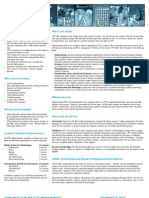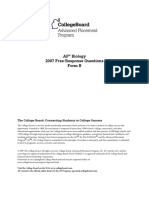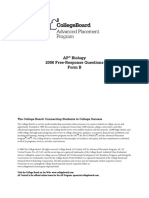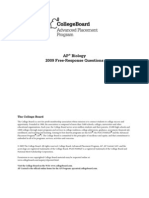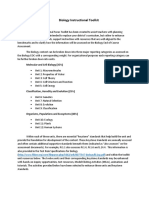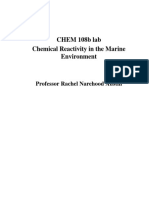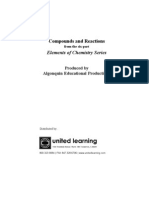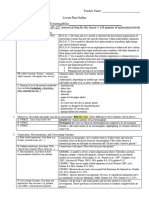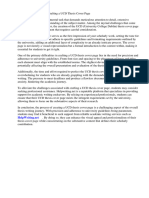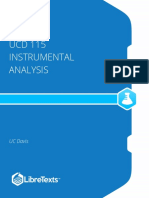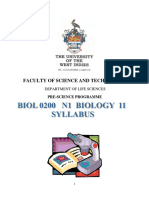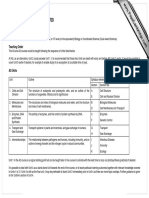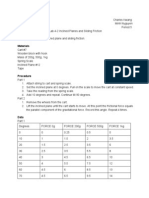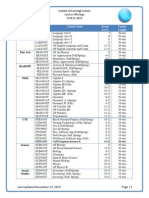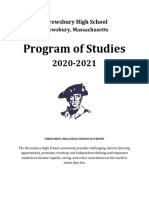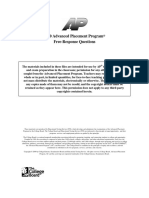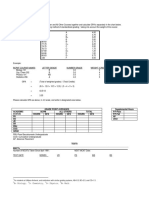0 ratings0% found this document useful (0 votes)
68 viewsAP Bio Essay 2002 A
AP Bio Essay 2002 A
Uploaded by
adhdnoy1A
Copyright:
© All Rights Reserved
Available Formats
Download as PDF, TXT or read online from Scribd
AP Bio Essay 2002 A
AP Bio Essay 2002 A
Uploaded by
adhdnoy10 ratings0% found this document useful (0 votes)
68 views4 pagesA
Copyright
© © All Rights Reserved
Available Formats
PDF, TXT or read online from Scribd
Share this document
Did you find this document useful?
Is this content inappropriate?
A
Copyright:
© All Rights Reserved
Available Formats
Download as PDF, TXT or read online from Scribd
Download as pdf or txt
0 ratings0% found this document useful (0 votes)
68 views4 pagesAP Bio Essay 2002 A
AP Bio Essay 2002 A
Uploaded by
adhdnoy1A
Copyright:
© All Rights Reserved
Available Formats
Download as PDF, TXT or read online from Scribd
Download as pdf or txt
You are on page 1of 4
AP
Biology
2002 Free-Response Questions
These materials were produced by Educational Testing Service
(ETS
), which develops and administers the examinations oI the Advanced Placement
Program Ior the College Board. The College Board and Educational Testing Service (ETS) are dedicated to the principle oI equal opportunity, and their
programs, services, and employment policies are guided by that principle.
The College Board is a national nonproIit membership association dedicated to preparing, inspiring, and connecting students to college and opportunity.
Founded in 1900, the association is composed oI more than 4,200 schools, colleges, universities, and other educational organizations. Each year, the
College Board serves over three million students and their parents, 22,000 high schools, and 3,500 colleges, through major programs and services in
college admission, guidance, assessment, Iinancial aid, enrollment, and teaching and learning. Among its best-known programs are the SAT
, the
PSAT/NMSQT
, and the Advanced Placement Program
(AP
). The College Board is committed to the principles oI equity and
excellence, and that commitment is embodied in all oI its programs, services, activities, and concerns.
Copyright 2002 by College Entrance Examination Board. All rights reserved. College Board, Advanced Placement Program, AP, SAT, and the acorn logo
are registered trademarks oI the College Entrance Examination Board. APIEL is a trademark owned by the College Entrance Examination Board. PSAT/NMSQT is a
registered trademark jointly owned by the College Entrance Examination Board and the National Merit Scholarship Corporation.
Educational Testing Service and ETS are registered trademarks oI Educational Testing Service.
The materials included in these files are intended for use by AP teachers for course
and exam preparation in the classroom; permission for any other use must be
sought from the Advanced Placement Program
. Teachers may reproduce them, in
whole or in part, in limited quantities, for face-to-face teaching purposes but may
not mass distribute the materials, electronically or otherwise. These materials and
any copies made of them may not be resold, and the copyright notices must be
retained as they appear here. This permission does not apply to any third-party
copyrights contained herein.
2002 AP
BIOLOGY FREE-RESPONSE QUESTIONS
Copyright 2002 by College Entrance Examination Board. All rights reserved.
Advanced Placement Program and AP are registered trademarks of the College Entrance Examination Board.
GO ON TO THE NEXT PAGE.
2
BIOLOGY
SECTION II
Time1 hour and 30 minutes
Directions: Answer all questions.
Answers must be in essay form. Outline form is not acceptable. Labeled diagrams may be used to supplement
discussion, but in no case will a diagram alone suffice. It is important that you read each question completely before
you begin to write. Write all your answers on the pages following the questions in this booklet.
1. The human genome illustrates both continuity and change.
(a) Describe the essential features of two of the procedures/techniques below. For each of the procedures/
techniques you describe, explain how its application contributes to understanding genetics.
The use of a bacterial plasmid to clone and sequence a human gene
Polymerase chain reaction (PCR)
Restriction fragment length polymorphism (RFLP) analysis
(b) All humans are nearly identical genetically in coding sequences and have many proteins that are identical
in structure and function. Nevertheless, each human has a unique DNA fingerprint. Explain this apparent
contradiction.
2002 AP
BIOLOGY FREE-RESPONSE QUESTIONS
Copyright 2002 by College Entrance Examination Board. All rights reserved.
Advanced Placement Program and AP are registered trademarks of the College Entrance Examination Board.
GO ON TO THE NEXT PAGE.
3
2. The activities of organisms change at regular time intervals. These changes are called biological rhythms. The
graph depicts the activity cycle over a 48-hour period for a fictional group of mammals called pointy-eared
bombats, found on an isolated island in the temperate zone.
(a) Describe the cycle of activity for the bombats. Discuss how three of the following factors might affect the
physiology and/or behavior of the bombats to result in this pattern of activity.
temperature
food availability
presence of predators
social behavior
(b) Propose a hypothesis regarding the effect of light on the cycle of activity in bombats. Describe a controlled
experiment that could be performed to test this hypothesis, and the results you would expect.
3. The complexity of structure and function varies widely across the animal kingdom. Despite this variation,
animals exhibit common processes. These include the following.
transport of materials
response to stimuli
gas exchange
locomotion
(a) Choose two of the processes above and for each, describe the relevant structures and how they function
to accomplish the process in the following phyla.
Cnidaria (e.g., hydra, jellyfish)
Annelida (e.g., earthworm)
Chordata (e.g., mouse)
(b) Explain the adaptive (evolutionary) value(s) of the structural examples you described in part a.
2002 AP
BIOLOGY FREE-RESPONSE QUESTIONS
Copyright 2002 by College Entrance Examination Board. All rights reserved.
Advanced Placement Program and AP are registered trademarks of the College Entrance Examination Board.
4
4. The following experiment was designed to test whether different concentration gradients affect the rate of
diffusion. In this experiment, four solutions (0% NaCl, 1% NaCl, 5% NaCl , and 10% NaCl) were tested under
identical conditions. Fifteen milliliters (mL) of 0% NaCl were put into a bag formed of dialysis tubing that is
permeable to Na
+
, Cl
-
, and water. The same was done for each NaCl solution. Each bag was submerged in a
separate beaker containing 300 mL of distilled water. The concentration of NaCl in mg/L in the water outside
each bag was measured at 40-second intervals. The results from the 5% bag are shown in the table below.
CONCENTRATION IN mg/L OF NaCl OUTSIDE THE 5% NaCl BAG
Time
(seconds)
NaCl
(mg/L)
0 0
40 130
80 220
120 320
160 400
(a) On the axes provided, graph the data for the 5% NaCl solution.
(b) Using the same set of axes, draw and label three additional lines representing the results that you would
predict for the 0% NaCl, 1% NaCl, and 10% NaCl solutions. Explain your predictions.
(c) Farmlands located near coastal regions are being threatened by encroaching seawater seeping into the soil.
In terms of water movement into or out of plant cells, explain why seawater could decrease crop production.
Include a discussion of water potential in your answer.
END OF EXAMINATION
You might also like
- AP Biology Premium, 2025: Prep Book with 6 Practice Tests + Comprehensive Review + Online PracticeFrom EverandAP Biology Premium, 2025: Prep Book with 6 Practice Tests + Comprehensive Review + Online PracticeNo ratings yet
- Chemistry Companion E-Textbook - Volume 1: Foundations of ChemistryFrom EverandChemistry Companion E-Textbook - Volume 1: Foundations of ChemistryNo ratings yet
- Writing Unseen Commentaries - WordSmith 2007Document181 pagesWriting Unseen Commentaries - WordSmith 2007Abdulahi MaxamedNo ratings yet
- 500 AP Chemistry Questions To Know by Test DayDocument260 pages500 AP Chemistry Questions To Know by Test DayGhulam Hussain Waswano100% (3)
- Mit Fact SheetDocument2 pagesMit Fact SheetSatish RevuruNo ratings yet
- Ap08 Biology Form B FRQDocument3 pagesAp08 Biology Form B FRQJessica TsengNo ratings yet
- AP Biology 2008 Free-Response Questions: The College Board: Connecting Students To College SuccessDocument4 pagesAP Biology 2008 Free-Response Questions: The College Board: Connecting Students To College SuccessJonathan ChuNo ratings yet
- AP Biology 2007 Free-Response Questions: The College Board: Connecting Students To College SuccessDocument4 pagesAP Biology 2007 Free-Response Questions: The College Board: Connecting Students To College SuccessJonathan ChuNo ratings yet
- Ap10 FRQ Biology Formb PDFDocument3 pagesAp10 FRQ Biology Formb PDFJonathan ChuNo ratings yet
- AP Biology 2007 Free-Response Questions Form B: The College Board: Connecting Students To College SuccessDocument3 pagesAP Biology 2007 Free-Response Questions Form B: The College Board: Connecting Students To College SuccessJonathan ChuNo ratings yet
- 2012 FRQ BiologyDocument4 pages2012 FRQ Biologywrik.datta.xNo ratings yet
- Ap06 FRQ Biology Rev 51780Document3 pagesAp06 FRQ Biology Rev 51780wrik.datta.xNo ratings yet
- AP Environmental Science 2001 Free-Response QuestionsDocument5 pagesAP Environmental Science 2001 Free-Response Questionsskyy93No ratings yet
- AP Biology 2006 Free-Response Questions Form B: The College Board: Connecting Students To College SuccessDocument3 pagesAP Biology 2006 Free-Response Questions Form B: The College Board: Connecting Students To College SuccessBreanna SuarezNo ratings yet
- 2005 FRQDocument4 pages2005 FRQlmathew2766No ratings yet
- Ir Assignment TableDocument8 pagesIr Assignment Tableafoddlkrjjapgw100% (1)
- AP Biology 2009 Free-Response Questions: The College BoardDocument4 pagesAP Biology 2009 Free-Response Questions: The College BoardsophisticatedslutNo ratings yet
- Research Lesson Plan Final DraftDocument10 pagesResearch Lesson Plan Final Draftapi-356036396No ratings yet
- SISTEM MODULAR: 964 SP BiologyDocument105 pagesSISTEM MODULAR: 964 SP BiologySifu KNo ratings yet
- AP Envi Syllabus.Document15 pagesAP Envi Syllabus.Sherlyn TalleNo ratings yet
- A2 Edexcel Biology Coursework TopicsDocument6 pagesA2 Edexcel Biology Coursework Topicstgpazszid100% (2)
- Marine Engineering Thesis ExamplesDocument7 pagesMarine Engineering Thesis Examplespatriciaviljoenjackson100% (1)
- Thesis PDF DownloadDocument4 pagesThesis PDF Downloadjeanarnettrochester100% (1)
- Cbse-9 SCIENCE PracticalDocument49 pagesCbse-9 SCIENCE Practicalpace_saNo ratings yet
- AP Biology Syllabus 2009-2010Document10 pagesAP Biology Syllabus 2009-2010yulianaholicNo ratings yet
- Ap11 FRQ BiologyDocument3 pagesAp11 FRQ BiologyAnkit BhandaryNo ratings yet
- Science 2015 PDFDocument15 pagesScience 2015 PDFashwaniNo ratings yet
- Biology1 ToolkitDocument29 pagesBiology1 ToolkitChristelle AbaoNo ratings yet
- Scheme of Work Science Stage 8.v1Document51 pagesScheme of Work Science Stage 8.v1gkawsar22100% (2)
- 108 Blab ManualDocument28 pages108 Blab ManualPysadee PysadeeNo ratings yet
- CHEM 108b Lab Chemical Reactivity in The Marine Environment: Professor Rachel Narehood AustinDocument28 pagesCHEM 108b Lab Chemical Reactivity in The Marine Environment: Professor Rachel Narehood AustinPysadee PysadeeNo ratings yet
- Aptc (Ehsc) 3080.syllabus.2009Document8 pagesAptc (Ehsc) 3080.syllabus.2009Lee SellersNo ratings yet
- Florida Tech ThesisDocument8 pagesFlorida Tech Thesisdarlenehernandezdenver100% (2)
- AP Biology CourseworkDocument8 pagesAP Biology Courseworkafiwftfbu100% (2)
- Evaluating Human Impact On The Environment Student Guide (Complete)Document5 pagesEvaluating Human Impact On The Environment Student Guide (Complete)bestwaifuneverdiesNo ratings yet
- Sample Thesis For Maritime StudentsDocument8 pagesSample Thesis For Maritime StudentsdwsmjsqyNo ratings yet
- A Computational Fluid Dynamics Model of Algal Growth Development and ValidationDocument11 pagesA Computational Fluid Dynamics Model of Algal Growth Development and ValidationsuyyinNo ratings yet
- Types of AP Biology Exam QuestionsDocument6 pagesTypes of AP Biology Exam QuestionsPkanNo ratings yet
- Biology Specimen BookletDocument124 pagesBiology Specimen BookletDiana PhiriNo ratings yet
- Assignment 2 (2015) - Solution GuideDocument16 pagesAssignment 2 (2015) - Solution GuideSheila Isadru0% (1)
- Full 3Document67 pagesFull 3Allaa Mahad BourahlaNo ratings yet
- Eeas ThesisDocument8 pagesEeas Thesisaliyahhkingnewark100% (2)
- Free Thesis Download PDFDocument7 pagesFree Thesis Download PDFFiona Phillips100% (2)
- Thesis Dot HfuDocument7 pagesThesis Dot Hfutiffanyrobinsonmilwaukee100% (2)
- 9693 Marine Science As Teacher SupportDocument32 pages9693 Marine Science As Teacher SupportBunyameen BunNo ratings yet
- Chemistry Compounds TeacherDocument33 pagesChemistry Compounds TeacherKari Kristine Hoskins BarreraNo ratings yet
- AP Bio EssaysDocument34 pagesAP Bio EssayshyacyntheNo ratings yet
- Ecology Research Paper ExampleDocument8 pagesEcology Research Paper Exampleafnkyarofeepzh100% (1)
- Science CourseworkDocument5 pagesScience Courseworkafayememn100% (2)
- Mirzaee 2021Document13 pagesMirzaee 2021Fatokhoma amadou CamaraNo ratings yet
- Lesson Plan ExtremophilesDocument5 pagesLesson Plan ExtremophilesJacob SalazarNo ratings yet
- BIOL 0100 Course SyllabusDocument20 pagesBIOL 0100 Course SyllabusKiller VNo ratings yet
- Uasb ThesisDocument4 pagesUasb Thesispatriciaviljoenjackson100% (2)
- Ucd Thesis Cover PageDocument5 pagesUcd Thesis Cover Pagesow1vosanyv3100% (2)
- UCD 115 Instrumental Analysis: UC DavisDocument73 pagesUCD 115 Instrumental Analysis: UC Daviskhanh khanhNo ratings yet
- Biol 0200 SyllabusDocument18 pagesBiol 0200 SyllabusShandev IndoiNo ratings yet
- AS and A2 Biology Syllabus 9700: Recommended Prior KnowledgeDocument4 pagesAS and A2 Biology Syllabus 9700: Recommended Prior KnowledgeMeily ZoelNo ratings yet
- Biology EssaysDocument35 pagesBiology Essayst rex422No ratings yet
- AP BiologyDocument5 pagesAP BiologyAnil ChauhanNo ratings yet
- SIWES Report Biochemistry FUNAAB CompleteDocument15 pagesSIWES Report Biochemistry FUNAAB CompleteAndrew NewmanNo ratings yet
- PHD Thesis University of SheffieldDocument5 pagesPHD Thesis University of Sheffieldafkofvidg100% (2)
- AP Environmental Science Premium, 2025: Prep Book with 5 Practice Tests + Comprehensive Review + Online PracticeFrom EverandAP Environmental Science Premium, 2025: Prep Book with 5 Practice Tests + Comprehensive Review + Online PracticeNo ratings yet
- LABORATORY MANUAL FOR A MINI PROJECT: MSCB 1113 BIOCHEMISTRY & MICROBIAL PHYSIOLOGYFrom EverandLABORATORY MANUAL FOR A MINI PROJECT: MSCB 1113 BIOCHEMISTRY & MICROBIAL PHYSIOLOGYNo ratings yet
- Daily Log 20144Document1 pageDaily Log 20144adhdnoy1No ratings yet
- ObjectiveDocument3 pagesObjectiveadhdnoy1No ratings yet
- LetterDocument5 pagesLetteradhdnoy1No ratings yet
- CHAPTER 23 - Geometric Optics-11Document4 pagesCHAPTER 23 - Geometric Optics-11adhdnoy1No ratings yet
- Chapter 23 QuestionsDocument1 pageChapter 23 Questionsadhdnoy1No ratings yet
- Chapter 23B Mirrors and Lenses WorksheetDocument1 pageChapter 23B Mirrors and Lenses Worksheetadhdnoy1No ratings yet
- One LinerDocument43 pagesOne Lineradhdnoy1100% (2)
- John Drew AnthonyDocument2 pagesJohn Drew AnthonyJohn AnthonyNo ratings yet
- MASD Comprehensive PlanDocument90 pagesMASD Comprehensive PlanPress And JournalNo ratings yet
- Groves Profile 19-20Document2 pagesGroves Profile 19-20api-479099463No ratings yet
- AP Honor List 2018Document2 pagesAP Honor List 2018Fauquier NowNo ratings yet
- 2013-2014 Dodea Virtual High School Course Offerings Nov 12Document2 pages2013-2014 Dodea Virtual High School Course Offerings Nov 12api-248819615No ratings yet
- Araling Panlipunan Action PlanDocument2 pagesAraling Panlipunan Action PlanGlenn Guarino0% (1)
- Program of Studies: Shrewsbury High SchoolDocument95 pagesProgram of Studies: Shrewsbury High SchoolShivank IssarNo ratings yet
- AP Art History: Course and Exam DescriptionDocument33 pagesAP Art History: Course and Exam Descriptionapi-250394805No ratings yet
- Ap Comparative Government and Politics Course OverviewDocument2 pagesAp Comparative Government and Politics Course Overviewapi-196719233No ratings yet
- Microsoft Word - Prachi Khanna ResumeDocument1 pageMicrosoft Word - Prachi Khanna Resumeapi-333768733No ratings yet
- Pierce County Academic Booster Club, IncDocument6 pagesPierce County Academic Booster Club, IncAmy NimmerNo ratings yet
- Abbreviations and Acronyms Commonly Used Within APS and ACTL June 2020Document2 pagesAbbreviations and Acronyms Commonly Used Within APS and ACTL June 2020Movies ArrivalNo ratings yet
- Strategic Plan NHCS 2022-2027Document69 pagesStrategic Plan NHCS 2022-2027Ben SchachtmanNo ratings yet
- The Ultimate Guide To US & UK Universities Booklet - Crimson EducationDocument15 pagesThe Ultimate Guide To US & UK Universities Booklet - Crimson Educationlokaiden975No ratings yet
- AP English Language Practice Test 04Document8 pagesAP English Language Practice Test 04Nour AllahhamNo ratings yet
- Apush 2018 PleaseaDocument112 pagesApush 2018 Pleaseakadenpizza66No ratings yet
- 2000 Advanced Placement Program Free-Response QuestionsDocument6 pages2000 Advanced Placement Program Free-Response QuestionsKeyan ChangNo ratings yet
- AP Computer Science ADocument2 pagesAP Computer Science AAngelaNo ratings yet
- SFUSD Course Catalog 13-14 v2Document115 pagesSFUSD Course Catalog 13-14 v2leonaailiNo ratings yet
- Gpa Calculation SheetDocument1 pageGpa Calculation SheetIryna HoncharukNo ratings yet
- Tanya Verma For PrintDocument29 pagesTanya Verma For Printthe projectshalaNo ratings yet
- Ap14 FRQ Calculus AbDocument7 pagesAp14 FRQ Calculus Abpradhanpranav70No ratings yet
- AP Precalculus Course OverviewDocument2 pagesAP Precalculus Course Overview19Tamal ChatterjeeNo ratings yet
- Resume Updated 9 20 20Document1 pageResume Updated 9 20 20api-525488943No ratings yet
- Andrew Resume WorkshopDocument1 pageAndrew Resume Workshopft7ccxlujdNo ratings yet
- PDF Sat Educator GuideDocument24 pagesPDF Sat Educator GuideraksnghNo ratings yet
- Planning Your Education: Page - 1 / 32Document32 pagesPlanning Your Education: Page - 1 / 32Dharma RajNo ratings yet




